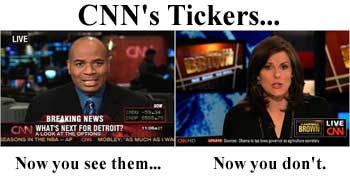A brief review of motion in digital signage spots
For anyone new to this blog, I translated last year's DSE content presentation into blog articles, creating a list of best practices for digital signage content creation. With regard to motion, I pointed out seven things to keep in mind when using motion (moving text or imagery) on your digital signs:
- Just because you can make it move doesn't mean that you should.
- Don't let motion interfere with readability or comprehension.
- You get only 1.5 - 3 seconds of full attention for glance media.
- Leave enough time to read the text.
- Treat moving text like it's not there at all (from a readability perspective).
- Motion on the periphery is more subtle than motion in the middle of the field of view.
- The most important features of your spot should be static.
As you can see, most of the tips focused on improving readability. Why is that? Well, you could have the most recognizable and iconic brand imagery in the world (and I'm talking mouse ears or golden arches), but unless your message is actually readable on-screen, your content isn't going to be performing up to its full potential. From a practical standpoint, I'd like to add three more items to the motion checklist:
- If you're the DESIGNER of the content, make sure you can read any on-screen copy 5 times in the time allotted. Quite simply, as the person most familiar with the copy, you're going to have a predisposition to vastly underestimate the amount of time it takes to read it. That's because you've not only had lots of practice reading it during the content development process (so it's already floating around in your memory), but also because you'll be familiar with the other distractions on screen (things like layout, animations, etc.)
- If you're a REVIEWER of the content, make sure you can read any on-screen copy 3 times in the time allotted. A good designer will hand off a semi-finished piece of content to at least one other person to review before signing off on it. This person might be familiar with the account or campaign being worked on, but should be looking at the piece with "fresh eyes," in order to offer up some constructive criticism. The reviewer should be able to read any copy that you have on-screen at least three times before it disappears. We've found this to be a good rule of thumb for approximating the amount of time it will take an average engaged viewer to actually read what's on screen in the screen's actual out-of-home venue.
- Ensure that the text can be read from a non-ideal angle of incidence. One common pitfall of designers and reviewers alike is that they typically view the content dead-on (e.g. perpendicular to the screen), and from only a few feet away. In reality, your content will probably never be seen like that out in the real world, so why would you review it like that? Take five big steps back, turn your head to the side a bit, and then see how easy or hard it is to get the gist of what's going on. I've seen more than my fair share of content that becomes unreadable if you're not staring at the screen from point-blank range, as I'm sure many of you have as well.

Oh tickers, how misunderstood you are. It's no wonder I get so many questions about using scrolling tickers. They look cool. They add motion and interest to static content on screen. And even though CNN toned down their tickers, they're still in full force at CNBC and other networks. Tickers seem to be quite popular, so they must be effective, right? Well, the truth is that unless you've got content that everyone is already used to looking at on a ticker (such as stock quotes), then a ticker is more or less the worst way to display it on screen. I've done a bit of research on the subject, but thankfully the boffins at Georgia Tech, Virginia Tech, Cornell, IBM and others have done many more in-depth experiments to determine the efficacy of using tickers to disseminate critical messages. This is a surprisingly popular area of research, probably because ticker displays are often used as notification systems that provide emergency/interrupt information to people performing primary tasks. The key takeaways from their studies are as follows:
- Moving text takes longer to recognize/comprehend: 2-10x the time -- or more. The faster the scroll, the lower the comprehension rate. And I include the "or more" since you can scroll a ticker really fast and drive comprehension down to 0% if you want to.
- Scrolling text has a 10-22% lower recall rate versus "fade in/fade out" delivery. Assuming that the text is on screen for the same amount of time in both cases, using a simple text "fader" to bring messages in and out with some visual appeal might be a better way to go, since the text is much more readable and memorable that way.
- In-place displays such as a fade or blast are better than motion-based displays like a ticker for rapid identification of items. More than just being less readable, text messages that scroll are actually harder to understand than those that fade or blink in and out, probably because our brains are simultaneously trying to keep track of the moving text while deciphering the letters, forming the words, and working out the meaning of the message.
Want to see some examples of great (and not so great) content?
There's one day left to vote for your favorite digital signage content over at the 2009 POPAI Digital Signage Viewer's Choice Awards. Even if you don't want to vote (for some reason), there's over a half hour of digital signage content online for you to review. Some of it is truly great. Some of it could probably use a pass or two through some of our best practices. But if you're a designer or creative director -- or even if you work in ad sales -- I suggest you take a look through the reel of content to see how other people have approached the problem of getting their message out on the moving screen.
Looking for more places to learn about content?
One other note: the folks at Strategy Institute are giving readers of this blog the opportunity to attend their 4th Annual Content Strategies Summit at a nice discount. The lineup looks pretty good, with Al Witteman from Tracy Locke, Christopher Gray from Saatchi X and Doug Bolin from Razorfish speaking, just to name a few. If you're interested in going, the discount code for our readers is WST10, which will entitle you to a 10% discount on top of the $500 early bird discount (which ends on March 30th). Perhaps I'll see you there!
Moving text and tickers are a hot-button issue in our industry, and something we continue to research. Do the points above match your experience, or even just your "gut feeling"? Leave a comment to let us know!


 Subscribe to the Digital Signage Insider RSS feed
Subscribe to the Digital Signage Insider RSS feed
Comments
RSS feed for comments to this post